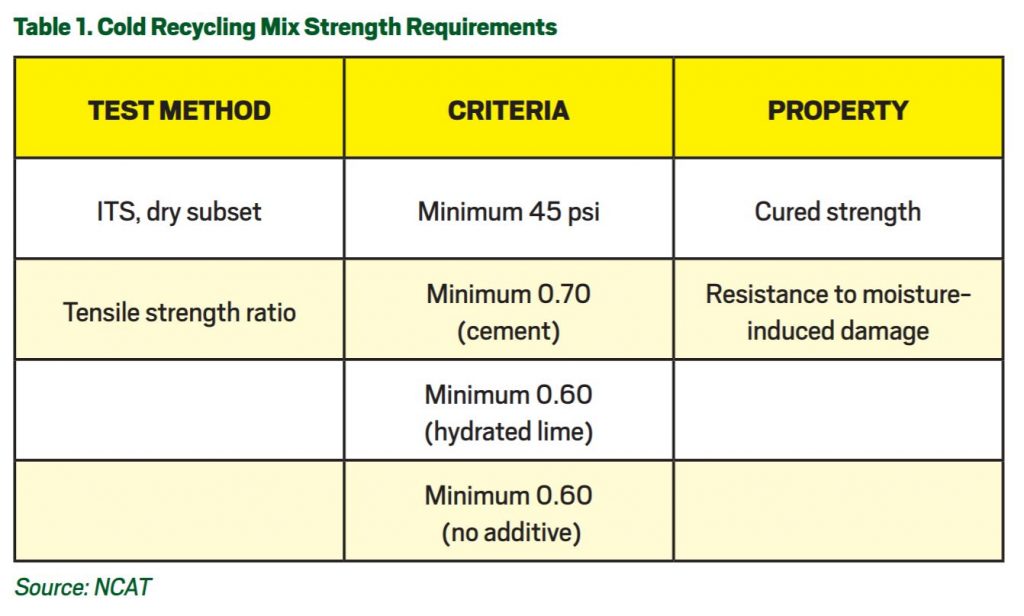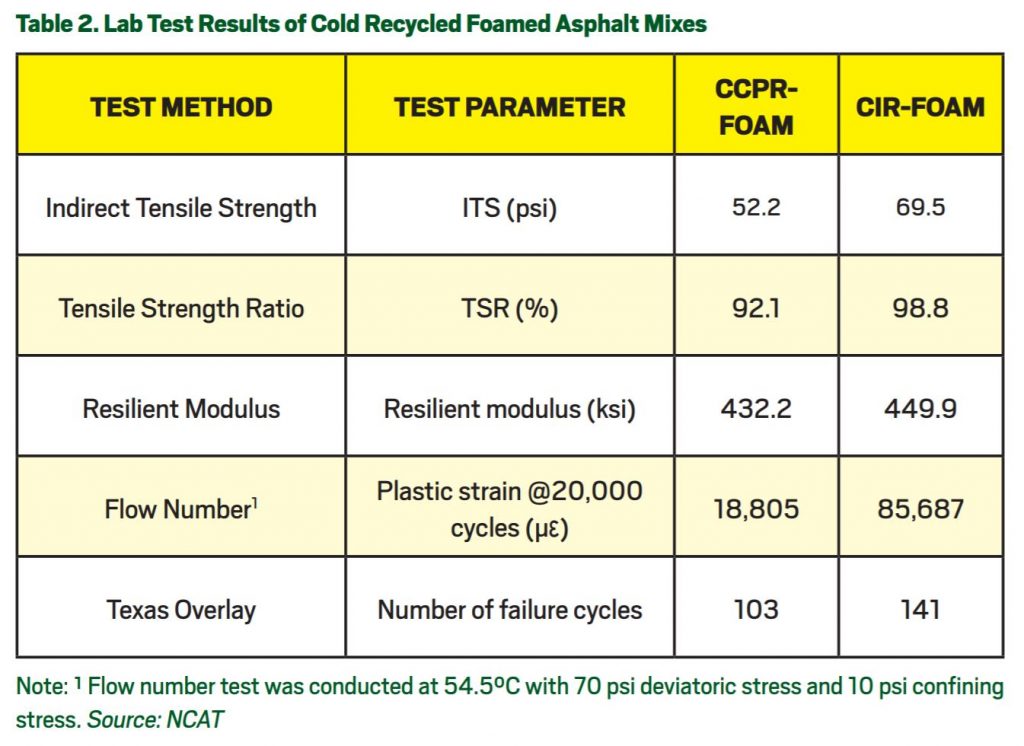NCAT Offers Cold Recycle Mix Design
BY Fan Gu and Benjamin Bowers

Editor’s Note: The first half of this article originally appeared in the spring 2019 NCAT newsletter and is reprinted here with permission. Additional information is from NCAT’s Benjamin Bowers in response to AsphaltPro questions regarding recycled asphalt pavement (RAP) stockpiling.
Cold in-place recycling (CIR) and cold central plant recycling (CCPR) are cost-effective and sustainable rehabilitation or reconstruction techniques for asphalt pavements. Cold recycled mixes are primarily composed of reclaimed asphalt pavement (RAP) and are produced at an ambient temperature; thus, these techniques require significantly less energy to produce. This results in generating fewer greenhouse gas emissions than traditional rehabilitation methods. CIR and CCPR mixes require 2 to 2.5 percent by weight of foamed or emulsified asphalt binder and water to achieve an optimum density and particle bonding. In many cases, these mixes also include an active filler to enhance short-term and long-term stiffness.
Researchers at the National Center for Asphalt Technology (NCAT) prepared a standard for cold recycling mix design with foamed asphalt, which has been published as AASHTO PP 94, Standard Specification for Determination of Optimum Asphalt Content of Cold Recycled Mixture with Foamed Asphalt. This standard specifies the requirements for material selection and documents the procedures to determine the amount of multiple binder components. The key steps of AASHTO PP 94 are highlighted as follows.

Cold in-place recycling (CIR)
The RAP is compacted by modified proctor at different water contents. The optimum water content is determined at the maximum dry density.
The RAP at the optimum water content is mixed with at least three trial foamed asphalt contents. An active filler is often added in this step to improve strength, rutting resistance, and moisture resistance. Hydrated lime, if used, is typically added at 1.0-1.5 percent by dry weight of RAP. Portland cement, if used, is typically kept between 0.25-1.0 percent by weight of RAP. Higher cement contents can be detrimental to performance.
The cold recycled mixture specimens are compacted with either a Superpave gyratory compactor at 30 gyrations or by Marshall hammer to 75 blows per side. Laboratory samples compacted using these two methods have provided density results comparable to those of field cores.
After compaction, the specimens are cured in a forced draft oven at 40 ± 1°C for 72 hours and then cooled to room temperature (i.e., 25 ± 1°C) for 24 hours. Research at NCAT has shown this curing protocol adequately reflects the strength gain of cold recycled foamed asphalt mixtures after 100 days of curing in the field.
The cured specimens are then divided into two subsets of three specimens each. One subset is soaked in the water bath at 25 ± 1°C for 24 hours, while the other subset is left in dry condition.
In the last step, indirect tensile strength (ITS) tests are performed on the specimens. The optimum foamed asphalt content is defined as the minimum binder content to meet the mixture strength requirement shown in Table 1.

Table 1. Cold Recycling Mix Strength Requirements
Source: NCAT
In 2015, NCAT used this mix design approach for the construction of one CIR and one CCPR test section on US280 in Lee County, Alabama. Both sections have a 4-inch cold recycled layer and a 1-inch Superpave mix overlay. For the CIR mix, the foamed asphalt content was 1.8 percent and the total water content was 4.9 percent. For the CCPR mix, the foamed asphalt content was 2.2 percent by weight of dry RAP, and the total water content was 7.2 percent by weight of dry RAP. Type I/II Portland cement was added at 1.5 percent for both CCPR and CIR mixes. This was higher than the suggested maximum cement content in AASHTO PP 94 but it was necessary to meet the dry ITS requirement.

Table 2. Lab Test Results of Cold Recycled Foamed Asphalt Mixes
Note: 1 Flow number test was conducted at 54.5°C with 70 psi deviatoric stress and 10 psi confining stress.
Source: NCAT
Table 2 shows the laboratory test results of these mixes. As presented, the designed CCPR mix had a higher rutting resistance but less cracking resistance than the CIR mix. As of February 2019, these two test sections had carried over 3.5 years of traffic with an estimated 2.3 million ESALs with no cracking and less than 0.25-inches of rutting.
NCAT researchers also completed a study to evaluate different active mineral fillers on the strength of cold recycled asphalt mixes. The four fillers evaluated were Portland cement, hydrated lime, Class C fly ash, and baghouse fines. The results indicated that mixes with cement and baghouse fines had higher dry ITS than those with hydrated lime and Class C fly ash, but mixes with cement and hydrated lime had higher wet ITS. Cement was the best overall mineral additive in terms of improvements to both dry and wet ITS. The study also found that sufficient moisture was needed to increase hydration of cement, thereby enhancing the strength of cold recycled asphalt mixes.
Reduce Stockpiling
There are a number of positives to using CCPR and the subsequent reduction of RAP stockpiles:
The use of the CCPR process can make roadway reconstruction a more feasible option for an owner agency. Work at NCAT, by the Virginia Department of Transportation, and elsewhere has shown that use of CCPR can result in a long-lasting, potentially perpetual pavement system.
If a contractor works with many mill-and-fill operations, the contractor is typically only placing 20-30 percent of the newly produced RAP back into the new hot mix, thus generating 70-80 percent RAP per ton of milled asphalt for any given project. Thus, stockpiles are only getting larger, not smaller. Reduced RAP stockpiles helps reduce land-use, either on the contractor’s yard or on property being rented by the contractor. This provides an economic benefit to the contractor. Using RAP in CCPR helps create an economically advantageous product that will help contractors in a low-bid system and/or make a value-engineering proposition. This will naturally benefit owner agencies, allowing them to pave further with their dollars.
The RAP is used in an asphalt pavement product as opposed to being used for less-beneficial uses (e.g. shoulder stone or fill material). While the mechanisms aren’t the same as hot mix, the RAP binder provides a viscoelastic response, similar to an HMA product.
Contractors may be able to use CCPR in commercial projects as a “green infrastructure” process, enabling the owner to collect green-building credits (LEED or other). The use of CCPR is an environmentally friendly, cost-effective way to rebuild pavement infrastructure. It has also been used for new roadways, including use along with full-depth reclamation (FDR) for lane additions, reconstruction, and widening on interstate projects.
Fan Gu, PhD, P.E., is an assistant research professor at NCAT, Auburn University; Benjamin Bowers, PhD, P.E., is an assistant professor in the Department of Civil Engineering, Auburn University. For more information, contact them at the NCAT office (334) 844-7328 or visit eng.auburn.edu/research/centers/ncat.
